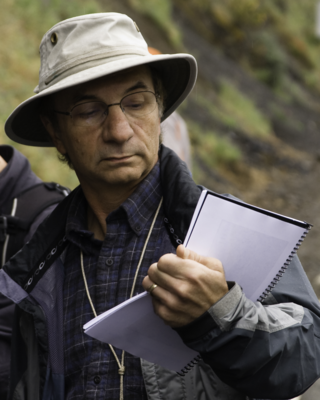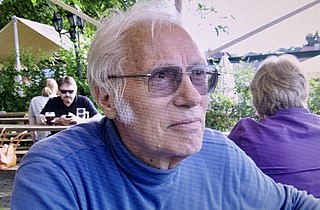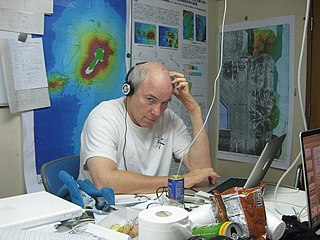
Tanya Atwater is an American geophysicist and marine geologist who specializes in plate tectonics. She is particularly renowned for her early research on the plate tectonic history of western North America.
Professor Henry "Harry" Elderfield, was Professor of Ocean Chemistry and Palaeochemistry at the Godwin Laboratory in the Department of Earth Sciences at the University of Cambridge. He made his name in ocean chemistry and palaeochemistry, using trace metals and isotopes in biogenic carbonate as palaeochemical tracers, and studying the chemistry of modern and ancient oceans - especially those of the glacial epoch and the Cenozoic.
Mary Lou Zoback is an American geophysicist and seismologist. A specialist in tectonic stress and natural hazards risks, she spent most of her career as a research scientist with the United States Geological Survey. Zoback chaired the World Stress Map project of the International Lithosphere Program from 1986 to 1992. Zoback served on the U.S. Nuclear Waste Technical Review Board from 2012 to 2018.

Leon Theodore "Lee" Silver was an American geologist who was professor of geology at the California Institute of Technology (Caltech). He was an instructor to the Apollo 13, 15, 16, and 17 astronaut crews. Working with the National Aeronautics and Space Administration (NASA), he taught astronauts how to perform field geology, essentially creating lunar field geology as a new discipline. His training is credited with a significant improvement in the J-Mission Apollo flights' scientific returns. After the Apollo program, he became a member of the United States National Academy of Sciences in 1974. He retired in 1996 as the W. M. Keck Foundation Professor for Resource Geology, emeritus, at Caltech.

Donald James DePaolo is an American professor of geochemistry in the department of earth and planetary science at the University of California, Berkeley and associate laboratory director for energy and environmental sciences at the Lawrence Berkeley National Laboratory.
George Edward Backus is an American geophysicist, best known for his work with J. Freeman Gilbert on inverse methods for geophysical data. He is also notably credited with advancing the dynamo theory on the origin of the Earth's magnetic field.

Miriam Kastner is a Bratislavan born, Israeli raised, American oceanographer and geochemist. Kastner is currently a distinguished professor at Scripps Institution of Oceanography at the University of California, San Diego. She is still recognized by her fundamental contributions to science and is well spoken of amongst colleagues.

Wolfgang "Wolf" Helmut Berger was a German-American oceanographer, geologist, micropaleontologist and emeritus professor at the Scripps Institution of Oceanography, University of California, San Diego. His research interests comprise "micropaleontology, marine sedimentation, ocean productivity, carbon cycle, ocean history, climate history, and history of oceanography."
Katherine H. Freeman is the Evan Pugh University Professor of Geosciences at Pennsylvania State University and a co-editor of the peer-reviewed scientific journal, Annual Review of Earth and Planetary Sciences. Her research interests are organic geochemistry, isotopic biogeochemistry, paleoclimate and astrobiology.
Meinrat O. Andreae, born in 1949 in Augsburg, is a German biogeochemist. Since 1987, he has worked as Director and Scientific Member at the Max Planck Institute for Chemistry (MPIC) in Mainz.
Ellen Druffel is an American oceanographer and isotope geochemist known for her research using radiocarbon to track marine processes.
Sethunathasarma Krishnaswami, popularly known as Swami, was an Indian geochemist and an honorary scientist at the geosciences division of the Physical Research Laboratory. He was known for his studies on low temperature geochemistry and was an elected fellow of the Indian Academy of Sciences, Indian National Science Academy, The World Academy of Sciences, National Academy of Sciences, India, American Geophysical Union, Geochemical Society and European Association of Geochemistry (2003). The Council of Scientific and Industrial Research, the apex agency of the Government of India for scientific research, awarded him the Shanti Swarup Bhatnagar Prize for Science and Technology, one of the highest Indian science awards for his contributions to Earth, atmosphere, ocean and planetary Sciences in 1984.

James Zachos is an American paleoclimatologist, oceanographer, and marine scientist. He is currently a professor in the Department of Earth and Planetary sciences at University of California, Santa Cruz where he was elected to the National Academy of Sciences in 2017. His research focuses on the biological, chemical, and climatic evolution of late Cretaceous and Cenozoic oceans, and how past climatic conditions help improve forecasts of the consequences of anthropogenic carbon emissions on future climate change.

Robert James (Bob) Stern is an American geoscientist based in Texas.

Roberta L. Rudnick is an American earth scientist and professor of geology at the University of California, Santa Barbara. She was elected a member of the National Academy of Sciences in 2010 and was awarded the Dana Medal by the Mineralogical Society of America. Rudnick is a world expert in the continental crust and lithosphere.
Lisa A. Levin is a Distinguished Professor of biological oceanography and marine ecology at the Scripps Institution of Oceanography. She holds the Elizabeth Hamman and Morgan Dene Oliver Chair in Marine Biodiversity and Conservation Science. She studies coastal and deep-sea ecosystems and is a Fellow of the American Association for the Advancement of Science.
Kimberly A. Prather is an American atmospheric chemist. She is a distinguished chair in atmospheric chemistry and a distinguished professor at the Scripps Institution of Oceanography and department of chemistry and biochemistry at UC San Diego. Her work focuses on how humans are influencing the atmosphere and climate. In 2019, she was elected a member of the National Academy of Engineering for technologies that transformed understanding of aerosols and their impacts on air quality, climate, and human health. In 2020, she was elected as a member of the National Academy of Sciences. She is also an elected Fellow of the American Philosophical Society, American Geophysical Union, the American Association for the Advancement of Science, American Philosophical Society, and the American Academy of Arts and Sciences.
Adina Paytan is a research professor at the Institute of Marine Sciences at the University of California, Santa Cruz. known for research into biogeochemical cycling in the present and the past. She has over 270 scientific publications in journals such as Science, Nature, Proceedings of the National Academy of Sciences, and Geophysical Research Letters.
Charlotte E. Keen is a Canadian geologist and professor emeritus at the Geological Survey of Canada. Her work focuses on the structure of the Earth's crust and the upper mantle using geophysical imaging and magnetic measurements. She was the first woman to go on a Canadian Survey Ship.
Rana Arnold Fine is Professor Emeritus at the University of Miami's Rosenstiel School of Marine and Atmospheric Science. Her research primarily addresses understanding ocean circulation processes over time through the use of chemical tracers and the connection to climate.







